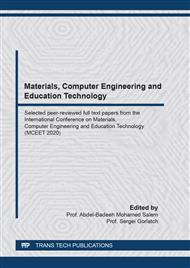[1]
A. K. Alvi et al., Pakistan Sign Language Recognition Using Statistical Template Matching,, Int. J. Inf. Technol. 1(1) 2004 1-12, vol. 1, no. 1, p.1–4, (2004).
Google Scholar
[2]
P. V. V. Kishore and P. Rajesh Kumar, A Video Based Indian Sign Language Recognition System (INSLR) Using Wavelet Transform and Fuzzy Logic,, Int. J. Eng. Technol., vol. 4, no. 5, p.537–542, 2012,.
DOI: 10.7763/ijet.2012.v4.427
Google Scholar
[3]
S. M. Darwish, M. M. Madbouly, and M. B. Khorsheed, Hand Gesture Recognition for Sign Language: A New Higher Order Fuzzy HMM Approach,, Int. J. Eng. Technol., vol. 8, no. 3, p.157–164, 2016,.
DOI: 10.7763/ijet.2016.v6.877
Google Scholar
[4]
S. Ali, Detection of Urdu Sign Language using Harr Algorithms,, Citeseer.
Google Scholar
[5]
Detection of Urdu Sign Language using Harr Algorithms - Google Scholar." [Online]. Available:https://scholar.google.com/scholar,hl=en&as_sdt=0%2C5&q=Detection+of+Urdu+Sign+Language+using+Harr+Algorithms&btnG=. [Accessed: 15-Dec-2020].
DOI: 10.7717/peerjcs.883/fig-8
Google Scholar
[6]
S. Kausar, M. Javed, … S. S. the 8th conference on S., and undefined 2008, Recognition of gestures in Pakistani sign language using fuzzy classifier,, researchgate.net.
Google Scholar
[7]
P. Buehler, … M. E.-P. of the, and undefined 2008, Long term arm and hand tracking for continuous sign language TV broadcasts,, eprints.whiterose.ac.uk.
DOI: 10.5244/c.22.110
Google Scholar
[8]
L. B. Martinez and E. P. G. Cabalfin, Sign Language and Computing in a Developing Country : A Research Roadmap for the Next Two Decades in the Philippines 2 . Overview of Current Trends in Automatic Analysis of Sign Language and,, 22nd Pacific Asia Conf. Lang. Inf. Comput., p.438–444, (2008).
Google Scholar
[9]
W. Kadous, GRASP: Recognition of Australian sign language using instrumented gloves,, (1995).
Google Scholar
[10]
I., Wachsmuth, T. Sowa (Eds.), "Towards an Automatic... - Google Scholar." [Online]. Available:https://scholar.google.com/scholar?hl=en&as_sdt=0%2C5&q=I.%2C+Wachsmuth%2C+T.+Sowa+%28Eds.%29%2C+"Towards+an+Automatic+Sign+Language+Recognition+System+using+Subunits,%2C+London%2C+April+2001%2C+pp.+1-2&btnG=. [Accessed: 15-Dec-2020].
DOI: 10.1002/chin.198449091
Google Scholar
[11]
S. K. Liddell, Grammar, gesture, and meaning in American sign Language,, Grammar, Gesture, Mean. Am. Sign Lang., no. 1980, p.1–384, 2003,.
DOI: 10.1017/cbo9780511615054
Google Scholar
[12]
W. C. Stokoe and M. Marschark, Sign language structure: An outline of the visual communication systems of the american deaf,, J. Deaf Stud. Deaf Educ., vol. 10, no. 1, p.3–37, 2005,.
DOI: 10.1093/deafed/eni001
Google Scholar
[13]
S. S. Rautaray and A. Agrawal, Vision based hand gesture recognition for human computer interaction: a survey,, Artif. Intell. Rev., vol. 43, no. 1, p.1–54, 2012,.
DOI: 10.1007/s10462-012-9356-9
Google Scholar
[14]
Vogler, C.&Metaxas, D. (2004). Handshapes and movements... - Google Scholar." [Online]. Available:https://scholar.google.com/scholar,hl=en&as_sdt=0%2C5&q=Vogler%2C+C.+%26+Metaxas%2C+D.+%282004%29.+Handshapes+and+movements%3A+Multiple-channel+ASL+recognition.+In+Springer++%09Lecture+Notes+in+Artificial+Intelligence.+Proceedings+of+the+Gesture+Workshop%2703%2C++Genova%2C+Italy.%2C+pages+247–+%09258.&btnG=. [Accessed: 15-Dec-2020].
DOI: 10.1007/978-3-540-24598-8_23
Google Scholar
[15]
Zhang, L.-G., Chen, Y., Fang, G., Chen, X., & Gao,... - Google Scholar." [Online]. Available: https://scholar.google.com/scholar,hl=en&as_sdt=0%2C5&q=Zhang%2C+L.-G.%2C+Chen%2C+Y.%2C+Fang%2C+G.%2C+Chen%2C+X.%2C+%26+Gao%2C+W.+%282004%29.+A+vision-based+sign+language+recognition+system++%09using+tied-mixture+density+hmm.+In+ICMI+%2704%3A+Proceedings+of+the+6th+international+conference+on+Multimodal++%09interfaces%2C+pages+198–204%2C+New+York%2C+NY%2C+USA.+ACM.&btnG=. [Accessed: 15-Dec-2020].
DOI: 10.2210/pdb6nyl/pdb
Google Scholar
[16]
S. Mitra, T. A.-I. T. on Systems, undefined Man, undefined and, and undefined 2007, Gesture recognition: A survey,, ieeexplore.ieee.org.
Google Scholar
[17]
C. Vogler, D. M.-I. G. Workshop, and undefined 2003, Handshapes and movements: Multiple-channel american sign language recognition,, Springer.
Google Scholar
[18]
Armstrong, D. F., Stokoe, W. C., Wilcox, S. E.: Gesture... - Google Scholar." [Online]. Available:https://scholar.google.com/scholar,hl=en&as_sdt=0%2C5&q=Armstrong%2C+D.+F.%2C+Stokoe%2C+W.+C.%2C+Wilcox%2C+S.+E.%3A+Gesture+and+the+natuer+of+language.+Cambridge+Academic+Press++%09%281995%29&btnG=. [Accessed: 15-Dec-2020].
DOI: 10.1017/cbo9780511620911
Google Scholar
[19]
Akyol: An information terminal using vision based... - Google Scholar." [Online]. Available:https://scholar.google.com/scholar,cluster=4725707678994008203&hl=en&as_sdt=0,5. [Accessed: 15-Dec-2020].
Google Scholar
[20]
C. Boldyreff, E. Burd, J. Donkin, and S. Marshall, The Case for the Use of Plain English to Increase Web Accessibility 2 . How Can Sites be made more accessible,, World Wide Web Internet Web Inf. Syst., vol. 1, p.1–7, (2001).
DOI: 10.1109/wse.2001.988784
Google Scholar
[21]
C. Wang, X. Chen, and W. Gao, Expanding training set for Chinese sign language recognition,, in FGR 2006: Proceedings of the 7th International Conference on Automatic Face and Gesture Recognition, 2006, vol. 2006, p.323–328,.
DOI: 10.1109/fgr.2006.39
Google Scholar
[22]
A. B. Domínguez and J. Alegria, Reading mechanisms in orally educated deaf adults,, J. Deaf Stud. Deaf Educ., vol. 15, no. 2, p.136–148, 2009,.
DOI: 10.1093/deafed/enp033
Google Scholar
[23]
P. Arnold and M. Mills, Memory for faces, shoes, and objects by deaf and hearing signers and hearing nonsigners,, J. Psycholinguist. Res., vol. 30, no. 2, p.185–195, 2001,.
Google Scholar
[24]
Esteban ML, editor. Libro blanco de la lengua de... - Google Scholar." [Online]. Available: https://scholar.google.com/scholar,hl=en&as_sdt=0%2C5&q=Esteban+ML%2C+editor.+Libro+blanco+de+la+lengua+de+signos+espa˜nola+en+el+sistema+educativo.+Madrid%3A+CNSE%3B+2003%2C++%09107++p.&btnG=. [Accessed: 15-Dec-2020].
DOI: 10.4321/repisalud.7946
Google Scholar
[25]
J. Fellinger, D. Holzinger, U. Dobner, … J. G.-S. P. and, and undefined 2005, An innovative and reliable way of measuring health-related quality of life and mental distress in the deaf community,, Springer.
DOI: 10.1007/s00127-005-0862-9
Google Scholar
[26]
N. Sulman, Pakistan Sign Language – A Synopsis,, academia.edu, (2000).
Google Scholar


